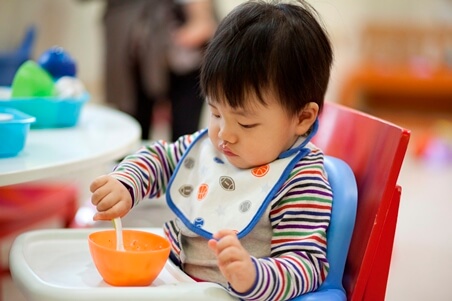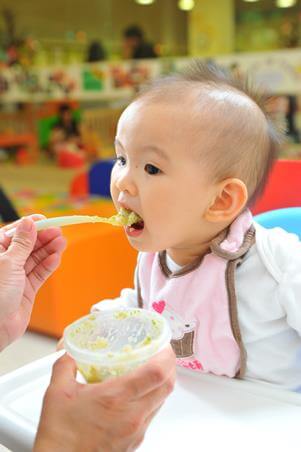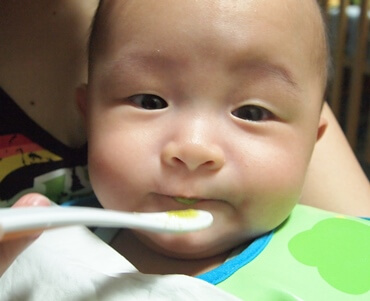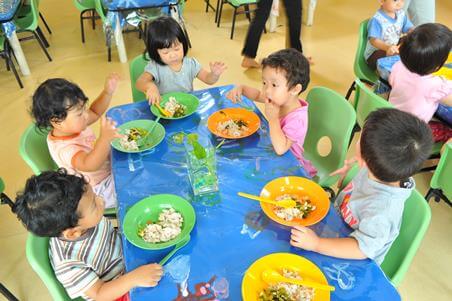Eats All Right

Prior to his first taste of solids, your baby would have been fed exclusively on breast or formula milk. The World Health Organization recommends exclusive breastfeeding for the first six months. Beyond six months of age, your baby won't be able to get all the nutrients he needs from milk alone. From here on, solid food plays an increasing important part in his diet and development.
Click here for tips on breastfeeding!
Let baby have his first taste of solids when he is about six months old. Although some babies are ready for solids earlier than this, it is advisable to wait until he is at least 17 weeks before starting him on solids. Before then, his gut and kidneys are still too immature to process the food. His throat muscles are also not developed enough yet to enable him to swallow solids. If you have any concerns about when to start baby on solids, do discuss it with a family doctor or a pediatrician.
Click here for tips on weaning baby!
A HEALTHY START IS A GOOD START
The key words to remember when planning meals for growing children are balance and variety. Use the Health Promotion Board's Healthy Plate as a guide. It shows key food groups and indicates which to eat more of and which to consume in small amounts.
Introducing baby to solids is an exciting milestone. By giving him a range of nutritious, fresh choices from an early age, you are setting him up for a lifetime of healthy eating habits. If you don't want your child to develop into a picky eater in the toddler years and beyond, try offering a variety of foods to build his tolerance for new tastes.
Aim for a balanced, child-friendly diet that includes carbohydrates, protein, essential fats, vitamins, calcium, iron and zinc. Most of these can be found in everyday foods like rice, meats, fruits and vegetables. Don't forget to offer cooled boiled water as well; it aids the digestive process and will keep your baby hydrated.
FROM 6 TO 18 MONTHS
Typically, baby's first taste of solids comes in the form of fruit purees (apple, pear) or baby rice cereal mixed with breast or formula milk. A finely mashed ripe banana is another popular choice. Start with a couple of teaspoons a day to complement his milk intake. If baby takes well to these foods, slowly introduce porridge, vegetables and meat -- all pureed, of course.

It's best to introduce new foods one at a time in case of allergies. You can experiment with an Asian-style chicken porridge, a potato and broccoli puree, beef and carrot casserole... just remember to place the cooked items into a food processor, blend and cool slightly before serving to baby. Use stock to thin the purees if they become too thick and lumpy. You want a smooth consistency that is easy for baby to swallow.
From 8 months, you can offer baby finger foods like ripe banana chunks, teething biscuits, steamed carrot batons and cooked pasta spirals. Make sure the food pieces are sized such that he is able to grip them comfortably with his fingers. Texture-wise, the food should be firm yet soft enough for your child to bite, chew and swallow. As babies mature at different rates, use your judgement to assess if he is ready for the finger-food stage. Be sure to supervise his self-feeding attempts to avoid chocking mishaps. Never leave your child unattended during meals.
Foods to avoid in the first 12 months include honey, peanuts, eggs, fish and shellfish. You should also go very easy on salt and sugar. Avoid canned sauces and condiments as these contain additives.

Baby's first spoon should be shallow with a soft tip to protect his gums. Such spoons are often referred to as 'weaning spoons'. To make meal times stimulating and fun, serve food from a colourful bowl featuring cutesy characters or his favourite cartoon hero. Don't forget to tie a bib loosely around baby - things will get a tad messy!
18 MONTHS TO 3 YEARS
Unlike the first 12 months, a child's growth rate slows when he reaches the toddler years. Accordingly, his appetite may decrease. As he is learning to talk and move around at this stage, he will probably be unwilling to sit still and finish a complete meal. With all that walking, jumping and running going on during this period of development, your toddler is going to need some energy-boosting snacks in between meals. Cut fresh fruit, slices of cheese, yogurt with fruit or a jam sandwich should fuel him up. As he gets older, cornflakes with milk, homemade chicken nuggets, muffins and cupcakes also make suitable snacks.
By the time your child is 18 months old, he should be over the pureed food stage. Of course, every child is different, so let your parental instincts lead the way. Once he starts teething, you may want to encourage him to bite and chew more.

A 3-year-old can ear practically anything that's served on the dining table: fried rice, chicken wings, spaghetti bolognese, steamed fish and vegetables... the list is adventurously long! He should be able to sit on his booster seat and have meals with mum and dad. To encourage self-feeding, get him cutlery with easy grips, and cheerfully designed toddler divider plates (anti-slip base, please) where different food items such as rice, steamed broccoli and honey-roasted chicken occupy their own special section of the plate.
3 TO 6 YEARS
The preschool years require a more structured eating schedule. Before sending him to preschool, make sure your child has a good breakfast. Cheese on toast, eggs boiled or scrambled, and pancakes make some good and easy-to-prepare choices.
Try this simple quiche recipe!
As he gets older, share with him the importance of good nutrition and explain, for instance, why he needs more calcium (to build strong bones and teeth) and iron (for optimal growth). Limit sugary foods and carbonated drinks. Encourage him to avoid junk or processed foods. If he enjoyes fast food, make healthier versions of it at home.
Dine together as a family and let him see you eating a variety of healthy foods such as fresh fruit or grilled chicken. If you constantly indulge in deep-fried foods, chocolates, potato chips or carbonated soft drinks, your child is likely to follow your eating habits.

In a preschool setting, your child will be encouraged to feed himself. He should be able to use a fork and spoon comfortably - give or take a few spills. Continue the routine at home and resist the urge to feed him. Instead, teach him not to talk with his mouth full, chew with his mouth open, play with his food or spit it out, and so on. With constant reminders and by setting a good example, your child will pick up the do's and don'ts of desirable table etiquette.
You may also like

From Cabin to Classroom: Journey of an Outstanding Early Childhood Educator
The PDP modules allowed me to get creative with lesson ideas and keep up with the ever-changing Early Childhood sector.

Ms Farhana Binte Mohamed Hassan
Early Years Educator - PCF Sparkletots @ Pioneer Block 987D (CC)

More Than Just a Place for Food
Young children are highly inquisitive, and learn most effectively with activities that allow exploration and experimentation.

Kinderland @ Yio Chu Kang

Little Fingers Create Great Art - A Community Project by Kinderland and Skool4kidz
I believe this collaborative effort is a very meaningful contribution to the SG50 celebrations.

Kinderland and Skool4Kidz